
The Field Museum of Natural History (FMNH), also known as The Field Museum, is a natural history museum in Chicago, Illinois, and is one of the largest such museums in the world. The museum is popular for the size and quality of its educational and scientific programs, and its extensive scientific specimen and artifact collections. The permanent exhibitions, which attract up to 2 million visitors annually, include fossils, current cultures from around the world, and interactive programming demonstrating today's urgent conservation needs. The museum is named in honor of its first major benefactor, Marshall Field, the department-store magnate. The museum and its collections originated from the 1893 World's Columbian Exposition and the artifacts displayed at the fair.

The American Museum of Natural History is a private 501(c)(3) natural history museum on the Upper West Side of Manhattan in New York City. In Theodore Roosevelt Park, across the street from Central Park, the museum complex comprises 26 interconnected buildings housing 45 permanent exhibition halls, in addition to a planetarium and a library. The museum collections contain over 34 million specimens of plants, animals, fungi, fossils, minerals, rocks, meteorites, human remains, and human cultural artifacts, as well as specialized collections for frozen tissue and genomic and astrophysical data, of which only a small fraction can be displayed at any given time. The museum occupies more than 2×10^6 sq ft (190,000 m2). AMNH has a full-time scientific staff of 225, sponsors over 120 special field expeditions each year, and averages about five million visits annually.

The Canadian Museum of Nature is a national natural history museum based in Canada's National Capital Region. The museum's exhibitions and public programs are housed in the Victoria Memorial Museum Building, a 18,910 square metres (203,500 sq ft) structure in Ottawa, Ontario. The museum's administrative offices and scientific centres are housed at a separate location, the Natural Heritage Campus, in Gatineau, Quebec.

The National Museum of Natural History is a natural history museum administered by the Smithsonian Institution, located on the National Mall in Washington, D.C., United States. It has free admission and is open 364 days a year. In 2021, with 7.1 million visitors, it was the eighteenth most visited museum in the world and the second most visited natural history museum in the world after the Natural History Museum in London. Opened in 1910, the museum on the National Mall was one of the first Smithsonian buildings constructed exclusively to hold the national collections and research facilities. The main building has an overall area of 1.5 million square feet (140,000 m2) with 325,000 square feet (30,200 m2) of exhibition and public space and houses over 1,000 employees.

Carl Ethan Akeley was a pioneering American taxidermist, sculptor, biologist, conservationist, inventor, and nature photographer, noted for his contributions to American museums, most notably to the Milwaukee Public Museum, Field Museum of Natural History and the American Museum of Natural History. He is considered the father of modern taxidermy. He was the founder of the AMNH Exhibitions Lab, the interdisciplinary department that fuses scientific research with immersive design.
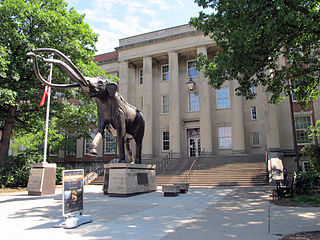
The University of Nebraska State Museum, also known as Morrill Hall, founded in 1871, is a natural history museum featuring Nebraska biodiversity, paleontology, and cultural diversity, located on the University of Nebraska–Lincoln City Campus near the corner of 14th and Vine Streets in Lincoln, Nebraska, United States. The museum houses Mueller Planetarium, a hands-on science discovery center, and the Elephant Hall, where visitors can see the world's largest articulated fossil mammoth among the collection of fossil elephants. Also featured are interactive paleontology exhibits, a dinosaur gallery, ancient life and evolution exhibits, wildlife dioramas, gems and minerals, American Indian and African exhibits, and a temporary exhibit gallery featuring rotating displays on diverse topics including photography, quilts and fine arts.

The Florida Museum of Natural History (FLMNH) is Florida's official state-sponsored and chartered natural-history museum. Its main facilities are located at 3215 Hull Road on the campus of the University of Florida in Gainesville.
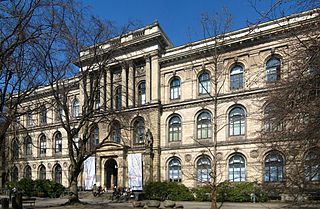
The Natural History Museum is a natural history museum located in Berlin, Germany. It exhibits a vast range of specimens from various segments of natural history and in such domain it is one of three major museums in Germany alongside Naturmuseum Senckenberg in Frankfurt and Museum Koenig in Bonn.

The Denver Museum of Nature & Science is a municipal natural history and science museum in Denver, Colorado. It is a resource for informal science education in the Rocky Mountain region. A variety of exhibitions, programs, and activities help museum visitors learn about the natural history of Colorado, Earth, and the universe. The 716,000-square-foot (66,519 m2) building houses more than one million objects in its collections including natural history and anthropological materials, as well as archival and library resources.

The Houston Museum of Natural Science is a natural history museum located on the northern border of Hermann Park in Houston, Texas, United States. The museum was established in 1909 by the Houston Museum and Scientific Society, an organization whose goals were to provide a free institution for the people of Houston focusing on education and science. Museum attendance totals over two million visitors each year. The museum complex consists of a central facility with four floors of natural science halls and exhibits, the Burke Baker Planetarium, the Cockrell Butterfly Center, and the Wortham Giant Screen Theatre. The museum is one of the most popular in the United States and ranks just below New York City's American Museum of Natural History and Metropolitan Museum of Art and the M. H. de Young Memorial Museum in San Francisco in most attendance amongst non-Smithsonian museums. Much of the museum's popularity is attributed to its large number of special or guest exhibits.
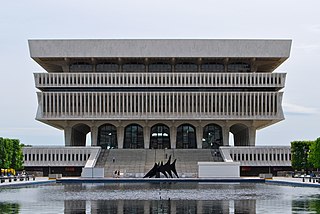
The New York State Museum is a research-backed institution in Albany, New York, United States. It is located on Madison Avenue, attached to the south side of the Empire State Plaza, facing onto the plaza and towards the New York State Capitol. The museum houses art, artifacts, and ecofacts that reflect New York’s cultural, natural, and geological development. Operated by the New York State Education Department's Office of Cultural Education, it is the oldest and largest state museum in the US. Formerly located in the State Education Building, the museum now occupies the first four floors of the Cultural Education Center, a ten-story, 1,500,000-square-foot (140,000 m2) building that also houses the New York State Archives and New York State Library.
The North Carolina Museum of Natural Sciences (NCMNS) is the largest museum of its kind in the Southeastern United States. It is the oldest established museum in North Carolina, located in Raleigh. In 2013, it had about 1.2 million visitors, and it was the state's most visited museum or historic destination among visitors.

The Iziko South African Museum is a South African national museum located in Cape Town. The museum was founded in 1825, the first in the country. It has been on its present site in the Company's Garden since 1897. The museum houses important African zoology, palaeontology and archaeology collections.
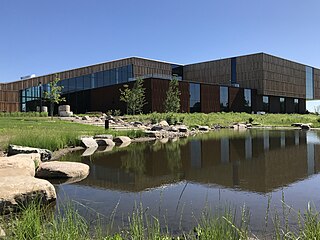
The Bell Museum, formerly known as the James Ford Bell Museum of Natural History, is located at the University of Minnesota. The museum's new location on the St. Paul campus opened in 2018. The Minnesota wildlife dioramas showcase animal specimens from around the world. The museum also houses the 120-seat digital Whitney and Elizabeth MacMillan Planetarium. The museum is part of the university's College of Food, Agricultural and Natural Resource Sciences. The museum's former location in Minneapolis is closed in January 2017.
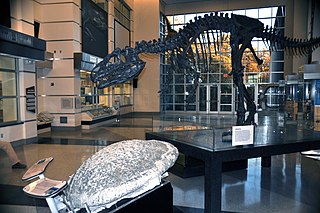
The Virginia Museum of Natural History is the state's natural history museum located in Martinsville, Virginia founded in 1984. The museum has several different award-winning publications, is affiliated with the Smithsonian Institution, and has more than 22 million items. This includes the first intact stromatolite head ever found in Virginia, which is one of the largest complete 'heads' in the world, at over 5 feet in diameter and weighing over 2 tons.

The University of Iowa Museum of Natural History is a natural history museum on the University of Iowa campus in Iowa City, Iowa. The museum was founded in 1858 by instruction of the Iowa General Assembly as the Cabinet of Natural History. It is housed within Macbride Hall, located in the Pentacrest area of the university campus. The museum's collections contain around 140,000 objects, including approximately 31,000 birds, eggs, and nests, 5,000 mammal specimens, 41,000 insects, 44,000 other invertebrates, 6,000 archaeological specimens, and historical documents and images from the museum's history. The museum includes several galleries on Iowa's geological and cultural history, biological diversity, and environmental science, spanning four floors. Major research collections include the Kallam Collection of prehistoric stone tools, the Talbot and Jones Bird Collections, the Frank Russell Collection of Inuit and Native Arctic artifacts, and the Philippine Collection of ethnographic materials from the 1904 World's Fair.
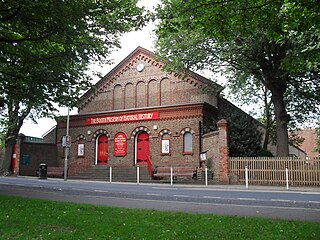
Booth Museum of Natural History is a charitable trust managed, municipally-owned museum of natural history in the city of Brighton and Hove in the South East of England. Its focus is on Victorian taxidermy, especially of British birds, as well as collections focusing on entomology, chalk fossils, skeletons and botany. It is part of "Royal Pavilion & Museums Trust". Admission to the museum is free.

The University of Michigan Museum of Natural History is a natural history museum of the University of Michigan in Ann Arbor, Michigan, United States.
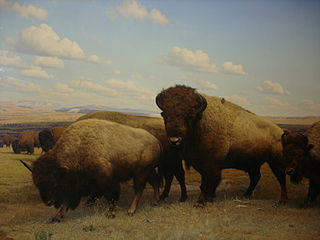
The conservation of taxidermy is the ongoing maintenance and preservation of zoological specimens that have been mounted or stuffed for display and study. Taxidermy specimens contain a variety of organic materials, such as fur, bone, feathers, skin, and wood, as well as inorganic materials, such as burlap, glass, and foam. Due to their composite nature, taxidermy specimens require special care and conservation treatments for the different materials.
Iron Hill Museum is a museum in Newark, Delaware, in the United States. Since 1968 it was located in a former African-American school, but moved to the new building in 2016.


















